A Capital Investment
"Next time you're in a new supermarket, or retail outlet, remember that, once upon a time, you might have been standing in the centre circle of a football pitch or on a cricket wicket"
Alex Welsh, LPFF Chief Executive
The London Playing Fields Society (now the London Playing Fields Foundation (LPFF)) was formed in 1890 by a group of visionary Victorians concerned with the need to protect London's open spaces for current and future generations.
By protecting the capital's playing fields from the threat of development, the newly-formed society was able to help sustain the public's enthusiasm for sporting and recreational pursuits.
More than a century later, the charity's work remains unchanged and unstinting, yet the challenge to safeguard precious green spaces has stiffened, as the density of urban living intensifies.
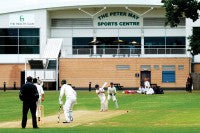 Throughout the 20th century, and into this millennium, the Foundation has successfully acquired grounds across London and currently numbers eight sites on its books.
Throughout the 20th century, and into this millennium, the Foundation has successfully acquired grounds across London and currently numbers eight sites on its books.
Every one of its 'projects' strives to increase participation in sport by offering community access to good quality sports pitches and facilities, with key usage groups including schools, clubs, disadvantaged and under-represented groups, as well as inactive people.
One of the most successful of LPFF's developments, which has proven the commercial viability of blending sound outdoor pitch provision with high quality indoor leisure, is the Peter May Sports Centre in Walthamstow, East London.
A former Inner London Education Authority (ILEA) site known as Wadham Lodge Sports Centre, the land was acquired by the Foundation in 1991 with the vision of creating a "regionally significant" cricket focus.
The centre is named after the former England cricket captain, Peter May, who was a Vice President of the LPFF from 1985 to 1994. The appeal was launched by his family and friends to commemorate Peter and his support for the LPFF.
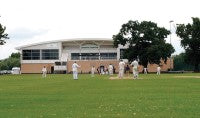
It is here that a young David Beckham played for three years, scoring over one hundred goals for his club, Ridgeway Rovers, prior to signing for Manchester United.
Plans and costings for redevelopment were drawn up in the early 1990s, but the earmarked £7.5m project cost proved too great at the time. "It wasn't until the introduction of the National Lottery in 1995 that the scheme got off the ground," explains Alex Welsh, LPFF chief executive.
In 2000, as a result of the Peter May Appeal, which raised £1.6m and funding from the National Lottery (£3.8m) and Waltham Forest (£475,000), the site was transformed into the Foundation's flagship facility, with a bespoke indoor cricket hall with cricket nets, a sand-filled artificial 2G pitch, complete with new drainage, a health and fitness club and changing rooms.
The thirty-four acres of playing fields include three mini football pitches, one junior football, four adult football and four cricket pitches, with the grounds playing host to some of the Foundation's innovative inclusion projects, such as Active Angels and Coping Through Football.
Users of the centre include local clubs, schools, universities, and it is also used for county and district fixtures, whilst also acting as a London base for the Essex County Cricket Board to identify and develop talented young cricketers.

The outdoor football pitches have also provided a home venue for Leyton Orient FC Girls Centre of Excellence. By working in partnership with operator, Greenwich Leisure Ltd., and other leisure providers at its venues, LPFF have established a successful business model, which combines a modern health and fitness centre with a first-class multi-sport hub that is able to generate income to reinvest back into turf maintenance programmes.
Six of their other seven locations, Fairlop Oak Playing Field; London Marathon Playing Field (LMPF) Redbridge; LMPF Greenwich; LMPF Greenford; Douglas Eyre Sports Centre, Boston Manor Playing Field, Hounslow are a mixture of indoor and outdoor provision, and making quality and inclusion their governing principles. The eighth site - Prince George's Playing Fields, Merton - is leased to David Lloyd Leisure Ltd.
For Alex, the key to the success of grass-roots pitches is in providing quality, because high standards generate throughput. "The best defence against playing field closures is high usage. If you can make fields attractive and of good quality, they will be well utilised. Only when standards slip does the community lose interest."
"In the beginning we felt that, to make this work, there needed to be multiple elements - not only high calibre playing fields, but also an indoor provision that would bring users to the site throughout the year," Alex explains.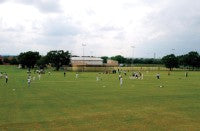
"As cricket was our biggest draw, we believed that making this a hub for the sport could prove successful, and there was nothing in the area working to the model we had planned - with the same level of indoor provision."
The indoor 27m x 31m sports hall was created to accommodate winter Uniturf cricket practice, with its six lanes, sprung floor and shockpad. It is the most heavily used indoor cricket facility in the region and a good part of the reason Essex County Cricket Club were attracted to the venue.
Whilst ensuring that a solid business model is in place is crucial to long-term sustainability, the primary goals of LPFF are to promote playing fields and ensure that pitches have a voice. For Alex, there still remains much to be done to see that playing fields are better utilised and maintained.
"Grass-roots developments need to be much more articulate in promoting their social and health benefits," says Alex, "and more effective at working in collaboration with business partners, often from outside the sports sector."
"As well as its health benefits, sport is a fantastic tool for engagement with hard to reach groups and brings the community together."
"Playing field usage should be underpinned by sports development principles, rather than marketed on a first come, first served basis. Too often the management, marketing and maintenance of local authority pitches are overseen by different departments working to different agendas," he insists.
 It is projects like the Peter May Sports Centre that Alex believes offer the kind of multi-use development needed to allow pitches to prosper.
It is projects like the Peter May Sports Centre that Alex believes offer the kind of multi-use development needed to allow pitches to prosper.
"The Peter May is a multi-sport hub - a sun in a solar system of smaller facilities. Such centres can help drive sports development locally," he states.
In the LPFF's work with the London Mayor's Office, they identified a network of existing and potential multi-sport hubs across the capital as part of a wider 2012 Legacy Plan for grass-roots sport.
The network provides a framework for strategic investment for the Mayor's Play Sport Legacy Fund. Each site within the framework complied with a set of key characteristics (based on the Peter May Sports Centre experience), which aimed at getting more people to play sport. The investment needed to develop the whole network was £173m, with only 13% matched funding already in place.
"At a time when there are many more opportunities to do things in what is classified as leisure time, we need to provide the best experience possible so that the customer wants to return time and again," he explains.
"This entails ensuring clubs have access to facilities that are not just attractive, but also are provided in the right location and used to full capacity. Clubs cannot rest on their laurels, expecting members to turn up every week."
"They should have an understanding of where the club fits within the bigger picture, and be prepared to change with the times. Just because a club has always existed, and has a history, does not mean that it is the right model for the 21st century."
One of the guiding principles of the LPFF's approach to pitch maintenance is to offer a solid start in the industry for young and aspiring groundsmen. The age bracket across their seven sites is wide; from their most senior groundsman, 65-year-old Colin Howard at Douglas Eyre, to the two youngest, who are both based at the Peter May Sports Centre.
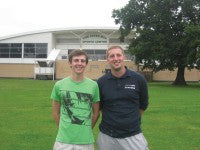 The turfcare duo, who are required to meet a punishing schedule of seasonal sports, are twenty-six year old Paul Cox and his assistant Billy Beech who, at only twenty, is the baby of the bunch.
The turfcare duo, who are required to meet a punishing schedule of seasonal sports, are twenty-six year old Paul Cox and his assistant Billy Beech who, at only twenty, is the baby of the bunch.
Paul joined the team six years ago having acquired an early taste for the industry from his uncle, Darren Rorie, who works at Boston Manor in Ealing. "I had never taken any formal qualifications in horticulture or groundsmanship, but the grounding I gained from my uncle is something that I will always value - it gave me the solid foundations I needed to help build a successful career in the industry," explains Paul.
After leaving school, he was faced with two career options - "gas or grass". Thankfully, for him and for the Foundation, he swept aside any thoughts of a gas maintenance job, jumped into groundsmanship and hasn't looked back.
For both Paul and Billy, the chance they have been given to take on such a big responsibility at an early age is one they relish and, it seems, is one they have taken in their stride.
Billy came to the centre fresh out of school, eager to start at the highest level he could. "Billy was eighteen when the post of head groundsman became vacant but, at the time, his experience wasn't quite enough for him to take on such a challenging role," explains Alex.
"Taking him on as an assistant was the best way forward, as it will allow him to develop and hone his skills so he can eventually take on a head groundsman position at one of our other sites," he adds.
Billy began his training at sixteen, with the LPFF meeting the costs of his education. Billy took his NVQ in Horticulture and later a BTec level 2 qualification in Sports Turf, which he received last year. Aspirations are high among the young LPFF staff.

"I definitely want to work in top-flight football one day," states Billy. "Seeing how much the profession has moved on in only a few years, and how people like Darren Baldwin at Spurs command much more respect than ever before, gives us something to aspire to."
For Alex, it's important to have the right mix of experience and youth in the ranks. "All the lads have a great relationship with each other and we share information and equipment between us," explains Paul. "It's important for us to show the older guys that we're just as capable and can deliver great playing surfaces here. We have regular meetings with each other so, when they come to us, we have a chance to show off our work."
Keen to also stress the sense of operational independence the groundstaff enjoy, Alex chimes in: "You won't find anyone checking their watches at 8.00am to make sure the lads have started on time. The proof of the pudding is in the eating, so we can tell if the pitches are up to scratch or not. The end user is a good guide of quality and we are soon told if they feel something is not right."
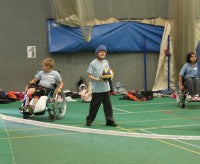 "We want to engender a sense of team spirit in our groundsmen," adds Alex, "which is why we put a big emphasis on meeting regularly to share ideas, and allow the younger staff to learn from the older guys."
"We want to engender a sense of team spirit in our groundsmen," adds Alex, "which is why we put a big emphasis on meeting regularly to share ideas, and allow the younger staff to learn from the older guys."
One of the biggest influences on Billy's development has been LPFF groundsman Dave Garrett, who sadly died of bowel cancer two years ago. "It was from Dave that I learned how to prepare a cricket wicket - tips that I will always remember him for," reveals Billy.
Learning how to maintain grass cut heights to prolong the life of the wicket was one of his most valued pieces of advice that Billy puts to good use during the summer.
"Keeping the grass to a 3-4mm height is vital to allow the wickets the longevity they need to cope with the volume of play we get here," Billy notes. "Despite the fact that some of our clubs would like it as short as possible, it's just not practical for us, and would end up ruining the wickets, so we have to maintain that extra length."
Paul again remembers his uncle as the one who offered him the most guidance in his early development, and it is cricket where his passion lies. "Perhaps the best piece of advice he gave me was how to scarify the square. At the time it was not the conventional approach, but I was taught to scarify in a diamond formation in a cross-hatching process. I find this brings greater results and works particularly well for our squares."
Timing also plays a key part in correctly preparing pitches and when to start work for a new season. As the football season is slightly longer, and can often run over, the pair like to leave the changeover as late as possible. "Seeding at the right time is important," says Billy, "and as the warmer weather seems to come much earlier, we have to tailor our times accordingly."
"We started seeding at the end of May this year due to the particularly warm and dry April but, in general, the margins between seeding, establishment and summer play are growing tighter."
It can sometimes be a thankless task having to cater for all tastes, especially when the margins between the winter and summer seasons are so tight. Paul and Billy only have a two-week window, once the whistle blows on the last football match of the twenty-eight week season, to bring the four cricket squares up to scratch for the beginning of their twenty week term.
"Any complaints received are always relayed back to the lads and we have a talk through whether the comments are fair or not," Alex explains. Billy adds: 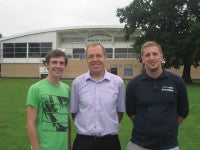 "Unfortunately, in our business, you cannot cater for everyone, especially with cricket, but we have to listen to people and make sure they feel that you have taken on board what they're saying."
"Unfortunately, in our business, you cannot cater for everyone, especially with cricket, but we have to listen to people and make sure they feel that you have taken on board what they're saying."
"There is no pecking order here. Every pitch is maintained to the same high standard, no matter who is playing on them, so everyone is entitled to their opinion."
Football and cricket both enjoy 95-100% usage throughout the season, the centre catering largely for schools and university fixtures mid-week, and a busy programme of club matches at weekends.
That leaves just Friday for Paul and Billy to repair any damage and bring the pitches up to the standard that participants have grown to expect.
When the LPFF embarked on the programme of investment at the centre, it was recognised that reliable equipment was essential to achieve the standards the Foundation expected.
"With our close links with Essex CCC, we asked their head groundsman, Stuart Kerrison, to draw up a wish list of machines he would choose if he could have anything," explains Alex.
"John Deere was the manufacturer that was named most often, so we made arrangements to test some equipment and eventually settled on a five-unit gang mower, a JD 466 tractor and a two-tonne Auto-roller, all of which we are still happily running ten years later. Before that, we had a horse and a plough," he quips.
Alongside the John Deere items, the team has two Ransomes walk behind wicket mowers, an Allett Regal, a Sisis Autorake, a Sisis manual rake, sand slitter and a Vertidrain that are shared among the seven locations.
As a charity, with little if any additional funding able to be pumped into grounds maintenance, the Foundation have to place machinery and equipment replacement on the back burner, and ensure that regular servicing and a make do and mend approach preserves the lifetime of the fleet.
"To prepare a good cricket pitch costs in the region of £300 a game, in manpower and supplies, so a big chunk of our budget goes on that," explains Alex. "The end user generally has no idea of the costs involved to deliver high standards. Fine turf surfaces require time and tender loving care, something that has not always been recognised by those controlling sport's purse-strings," he continues.
"At all LPFF grounds, our staff are the public's first point of contact, and it is critical that they develop a rapport with our users and partners, who have to be adaptable and buy into the philosophy of intensive use."
Alex believes that this philosophy has been dealt a massive blow with the introduction of Compulsory Competitive Tendering (CCT), which he insists "ravaged groundsmanship".
"It was hugely detrimental to professional turfcare, and led to poorly written maintenance contracts where work on a cricket square would be done in a matter of minutes, not hours."
Years of poor maintenance created a generation of bad wickets that became a health and safety issue, he insists, signalling the downfall of many urban green spaces.
"As the wickets worsened, they were used less and provided local authorities with a great excuse to get rid of them or sell off the land altogether."
The efforts of bodies such as LPFF too often pass unnoticed, Alex believes. He dubs the Foundation "London's best kept secret" because of the huge amount of work it puts into ensuring the capital keeps hold of as many of its playing fields as it can.
"Playing fields play a crucial role in sports development. Remember that all professional players started out at their local fields," Alex argues. "We need to not only make people more aware of their value but also of the importance of well-maintained playing surfaces to the future livelihood of grass-roots sport.
"There needs to be a massive investment to train a new generation of full-time, part-time and voluntary groundstaff. Thankfully, the sports governing bodies and associations are addressing this issue."
 As I prepare to head home amidst the throng of youngsters teeming into the Peter May Sports Centre, Alex leaves me with his most poignant reminder of the potentially parlous state of turfgrass sports facilities, one that will strike a chord with all who recognise the huge social value that playing fields bring to communities everywhere.
As I prepare to head home amidst the throng of youngsters teeming into the Peter May Sports Centre, Alex leaves me with his most poignant reminder of the potentially parlous state of turfgrass sports facilities, one that will strike a chord with all who recognise the huge social value that playing fields bring to communities everywhere.
"Next time you're in a new supermarket, or retail outlet, remember that, once upon a time, you might have been standing in the centre circle of a football pitch or on a cricket wicket.
"Once a playing fields is lost, it is lost for ever."
